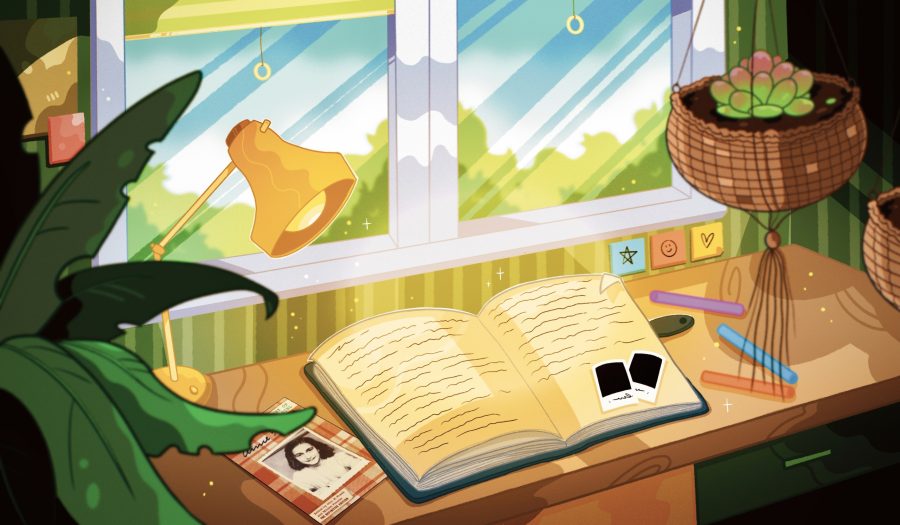Conversations with yourself: Journaling as a Form of Therapy and Evidence of Growth
Photo by Michelle Deng/ UCSD Guardian
Mar 12, 2023
In the fourth grade, Seventh College freshman Sarina Ghadiali received her first journal from her mom. It was green and pink and pocket-sized. She began drawing and making little doodles when her aunt suggested she write in it so she could have something to read and look back on. So, between the wide-ruled lines, her pointy handwriting began to fill the pages to describe her day-to-day events like, “today we had bagels for breakfast” or “we also started learning about fractions in school.”
Since elementary school, Ghadiali has taken to periodically journaling to retain a document of her life and her thoughts.
In the following year, as an assignment, Ghadiali wrote a letter to her high school senior self. The assignment was to write about what they were doing at the time and what they thought they would be doing as seniors. In ninth grade, they were assigned again to write another letter to their senior self.
“It was cool reading back on those letters because some of the things I said were actually true,” Ghadiali said. “Like I’m a marine biology major now just like I had written in those letters. It was also just funny to read the things I was thinking as a 9-year-old. It was cute.
Journaling, to many, is a treasured and versatile practice. Some people use prompts to spark their writing or have a daily set time to sit and write; others freely write whenever they feel like it. Some use it to relieve their mind of things they’re thinking about or to utilize journaling as a form of therapy.
The University of Rochester Medical Center recommends journaling for those who struggle with managing their mental health. Having a place to write one’s thoughts down can help with managing anxiety, reducing stress, and coping with depression. It helps by prioritizing and identifying fears and concerns, tracking symptoms to recognize triggers, and providing an opportunity for positive self-talk.
Thurgood Marshall College freshman Abigail Hahm shares her experience with journaling.
“I journal because it’s therapeutic,” Hahm said. “It’s satisfying. It gives me an outlet to just mind dump without having to bother people. And then I can look back at how I changed and grew over the years.”
Ghadiali similarly finds joy in the same aspects of journaling.
“I think it’s funny and interesting to read back on old journal entries where my mind was at different stages of my life,” Ghadiali said. “And I’m excited to continue looking back at what I write now and see how I’ve changed and grown.”
While many activities are done in public to be perceived, journaling is a personal and private activity. People confide in their journal, making it their “best friend.” It becomes a place for many to express and process human joy and grief.
In a 2006 study looking to identify the effects of writing and drawing about stressful events, 100 young adults journaled or drew for 15 minutes. The study found that the people who journaled had the biggest reduction in symptoms like depression, anxiety, and hostility.
Journaling is nothing new. Many iconic figures in history kept and wrote in journals, giving us something to look back on and their perspective on history.
Probably the most famous of diaries is Anne Frank’s, “The Diary of a Young Girl.” It has become a classic in literature regarding the Holocaust. Frank considered her diary a close friend, referring to it as “Kitty.”
When she first received her diary, she wrote, “I hope I will be able to confide everything to you, as I have never been able to confide in anyone, and I hope you will be a great source of comfort and support.”
She wrote about her day-to-day life during the war and in hiding, but also her dreams of becoming a journalist or writer. Despite these extreme circumstances, Frank’s diary doesn’t seem so far off from any young girl’s as she shares her greatest and wildest dreams. In any circumstance, a journal acts as a place for people to express their deep or surface-level thoughts.
Another famous diary is “The Unabridged Journals of Sylvia Plath.” Plath was well known for her poems and short stories. Her writing deals with her grappling with depression, her anxieties with her writing, and extremely descriptive interactions and parts of her days. Plath ended her life at the age of 30, showcasing a large part of her life to the public only after her death. The release of her journals revealed who she was — more than just a writer who took her own life, but a person with a complex mind who had good and bad days too.
Sally MacNamara Ivey, a diary collector, finds, reads, and researches diaries for a living and has read more than 10,000 unpublished journals. She aims to protect and respect the lives that created them and belonged to them before.
Ivey finds more and more value in diaries and journals — more value in people’s individual experiences and the strong belief that everyone holds a story worth sharing.
Whether imagined fantasies, an account of one’s day, or just the random thoughts that won’t leave one’s head, Ivey asserts that journaling can be an outlet for those thoughts. She notes that everyone’s stories are important and deserve to be heard and told. The written words of a person become a part of our history to live on forever.
Photo Courtesy of Michelle Deng

















